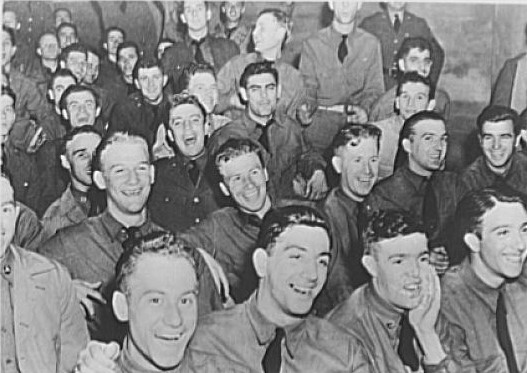
Audience response to the USO Camp Show. Library of Congress
How to register:
We offer two field trip scheduling options:
- Select a field trip from the Museum’s public event schedule
- Request to schedule a field trip at a time that meets your group’s schedule
Audience:
All audiences. Content appropriate for Grades 6-12.
Goal: Recognize how the Army values of selfless service and duty were channeled by civilians to support and uplift Soldiers during one of the darkest times in American History.
Program Description:
Laughter, celebrities, and frivolity are the sounds and images most closely associated with the United Services Organizations (USO) and more specifically the “Camp Show.” These professional-quality variety shows featured America’s most popular comedians, vocalists, and actors including Bob Hope, Lena Horne, Judy Garland, and Lucille Ball in some of World War II’s most uncertain battlefields. The shows brought Soldiers a brief respite from the uncertainty that lay ahead and an outlet for stress associated with wartime service.
While the lively nature of the “Camp Shows” stand out in American memory, the USO, provided both places of lively social activity and quiet contemplation to Soldiers seeking a morale boost, religious comfort, or a distraction. The USO was incorporated on February 4, 1941, to provide recreational opportunities and resources for World War II service members. The organization combined six social organizations into one formidable group that operated over 3,000 recreational clubs across the globe to provide Soldiers with lodging, food, resources, and entertainment.
Learn how the Army values of selfless service and duty were channeled by civilians to support and uplift Soldiers during one of the darkest times in American history. Identify how those values have been carried on since World War II to support Soldiers through times of war and peace.
Objective: At the end of this lesson students, will be able to
- Understand how civilians, through organizations like the USO, supported Soldiers during World War II.
- Describe the impact of World War II on the home front.
Guiding Questions:
How do civilians support the Army?
Curriculum Connections
Common Core Standards
- CCSS.ELA-LITERACY.RH.6-8.2
Determine the central ideas or information of a primary or secondary source; provide an accurate summary of the source distinct from prior knowledge or opinions.
History and Social Science Standards of Learning for Virginia Public Schools
-
United States History 1865 to Present
-
USII.6 The student will apply history and social science skills to understand the major causes and events of World War II and the effects of America’s role by
- G) evaluating the effects of the war on the home front, including, but not limited to women in the workforce, the incarceration of Japanese Americans, rationing, conservation, and war bonds.
-
USII.6 The student will apply history and social science skills to understand the major causes and events of World War II and the effects of America’s role by
-
Virginia and United States History
-
VUS.14 The student will apply history and social science skills to analyze the United States’ involvement in World War II by
- D) evaluating and explaining the contributions of heroic military units including, but not limited to segregated, minority units, women, and the role of Virginia units in the American war effort.
-
VUS.14 The student will apply history and social science skills to analyze the United States’ involvement in World War II by
Your message has been submitted.
